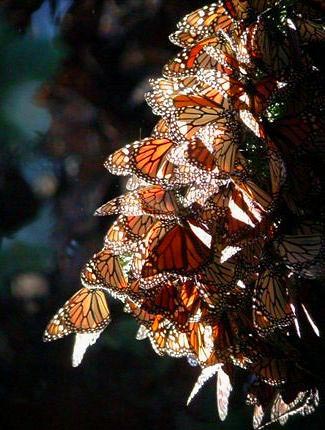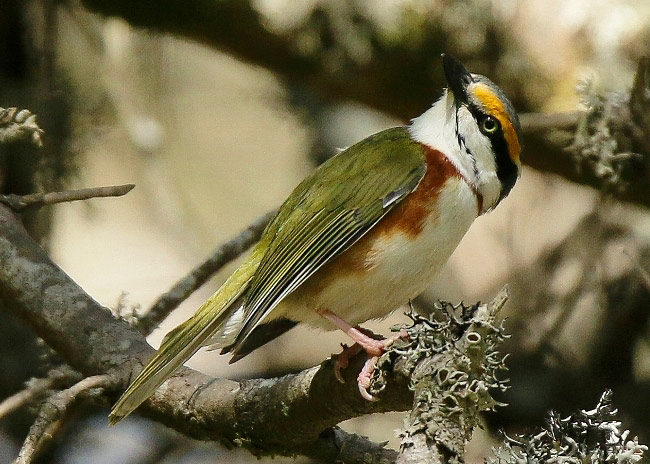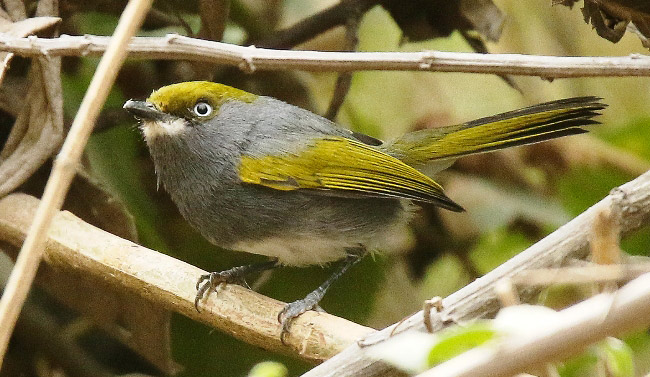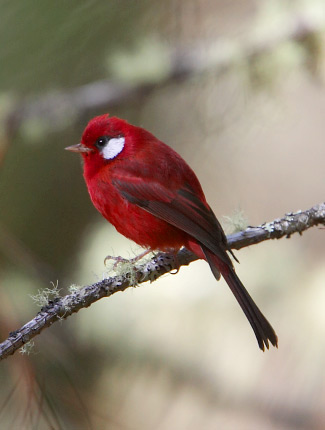

Monarchs at El Rosario by Nick Wall.
- Millions of Monarch butterflies at their winter roosts in the highland forests
- They look impressive covering the few trees they perch on but when they take to the air the scene is truly spectacular
- And many more beautiful butterflies
- Some of Mexico's 1000 or so bird species, of which over 120 are endemic and over 200 are regionally endemic, totals which in Central Mexico include Lilac-crowned Parrot, Bumblebee Hummingbird, Russet-crowned Motmot, San Blas Jay, Aztec Thrush, Chestnut-sided Shrike Vireo, many warblers including Red, and Orange-breasted Bunting
- As well as other spectacular birds such as Red-billed Tropicbird and Magnificent Frigatebird, along the Pacific coast
- With Humpback Whales and Spotted Dolphins
- Virtually all the Monarch butterflies in eastern North America migrate south up to 3000 miles (4800 km) to spend the winter in central Mexico. It is believed there may have been up to 600 million or even a billion of them not so long ago but now the long-term average is just 300 million and in February 2017 the estimated number in Mexico was 146 million. They still form enormous roosts in a few mountain fir forests, one of which is in the El Rosario Sanctuary outside the town of Angangueo in Michoacan state, about 125 miles (200 km) from Mexico City. It is a hard, steep climb up to the small grove of trees where the vast majority of the butterflies roost. They make an almost unbelievable sight, covering the trunks and branches, several butterflies deep in places, and look like giant creepers composed of golden butterflies. When the sunlight penetrates the canopy the butterflies begin to take to the air, singly at first then in small groups then in great swathes and soon the forest is full of them and the murmur of millions of wings is audible amongst the trees, the soundtrack to one of the most amazing scenes on Earth. But there is more. The butterflies then make their way out of the forest and by standing in one of the ‘flyways’ it is possible to watch a constant stream of them flutter by, centimetres away, to complete one of the best wildlife experiences there is.
- The dramatic decline in Monarch numbers is due to the usual list of reasons; too many people, leading to habitat loss, specifically stands of Milkweed, the plant the caterpillars feed on in North America, great swathes of which have been destroyed in the United States to make way for corn and other crops, mainly genetically modified ones made resistant to herbicides which Milkweed is not resistant to. Although numbers have risen since record lows, they are still way below historic levels. For the latest information see Monarch Butterfly
- The Monarchs are present at the same time as hundreds of whales, including Blue and confiding Greys, and thousands of dolphins, as well as Northern Elephant Seals, and birds such as Masked and Blue-footed Boobies, are in Baja California, where there is also the chance of swimming with sealions.
- Other destinations in Mexico include Veracruz, where the world's greatest raptor migration takes place in the autumn/fall, usually peaking from late September to mid-October, and Southern Mexico, a great place for Whales Sharks (from June to September, especially July) and many birds including Ocellated Turkey.


Chestnut-sided Shrike Vireo and Slaty Vireo by Brian Field. Just two of the many good-looking birds which can be seen in Mexico.
Best Birds and other wildlife in Central Mexico
Invertebrates
Millions of Monarch butterflies during the northern winter and many other butterflies including swallowtails
and heliconians.
Birds
Endemics Some, not all, of the species listed below are possible.
Widespread 14 White-naped Swift (the largest swift in the world), Curve-winged Sabrewing, Bumblebee Hummingbird, Cinereous (Mexican Barred) Owl, White-striped Woodcreeper, Spotted Wren, Blue Mockingbird, Aztec Thrush, Russet Nightingale-thrush, Rufous-backed Thrush, Collared Towhee, Striped Sparrow, Hooded Yellowthroat and Red Warbler.
Central 5 Mexican (King) Rail, Strickland’s Woodpecker, Ultramarine Jay, Black-backed Oriole and Black-polled Yellowthroat (small range).
West 33 Western Thicket Tinamou, Rufous-bellied Chachalaca, Eared Poorwill, Mexican Hermit, Short-crested Coquette (small range), Golden-crowned Emerald, White-tailed Hummingbird (small range), Mexican Woodnymph, Mexican Squirrel-cuckoo, Colima Pygmy-owl, Balsas Screech-owl, Citreoline Trogon, Grey-crowned Woodpecker, Golden-cheeked Woodpecker, Lilac-crowned Amazon, Mexican Parrotlet, Thick-billed Parrot, Western Grey-collared Becard, Flammulated Flycatcher, Golden Greenlet (Vireo), Sinaloa Crow, Black-throated Magpie-jay, San Blas Jay, Sclater’s (Rufous-naped) Wren, Happy Wren, Sinaloa Wren, Green-striped Brush-finch (also central), Rusty-crowned Ground-sparrow, Sierra Madre Sparrow (also central), Orange-breasted Bunting, Slate-blue Seedeater, Red-headed Tanager and Cinnamon-rumped (White-collared) Seedeater.
Southwest 25 West Mexican Chachalaca, Banded Quail, Long-tailed Wood-partridge, Spot-breasted Quail, White-fronted Swift, Dusky Hummingbird, Turquoise-crowned Hummingbird, Oaxaca (Blue-capped) Hummingbird, Cinnamon-sided (Green-fronted) Hummingbird, Beautiful Hummingbird, Wagler’s (Emerald) Toucanet, Grey-breasted Woodpecker, Pileated Flycatcher, Slaty Vireo, Dwarf Vireo, White-throated Jay, Boucard’s Wren, Ocellated Thrasher, Cinnamon-tailed Sparrow (small range), Black-chested Sparrow, Bridled Sparrow, White-throated Towhee, Oaxaca Sparrow, Fuertes’s (Orchard) Oriole (winter/east in summer) and Rose-bellied (Rosita’s) Bunting.
Near-endemics
Lesser Roadrunner, Sparkling-tailed Woodstar, Mountain Trogon, Russet-crowned Motmot, Chestnut-sided Shrike Vireo, Grey Silky, Golden-browed Warbler,
Red-breasted Chat and Cinnamon-bellied Flowerpiercer. Also a chance of Hooded Grosbeak.
Others
Red-billed Tropicbird, Magnificent Frigatebird, Brown Booby, Bare-throated Tiger Heron, Reddish Egret, Boat-billed Heron, raptors including Crested
Caracara, Limpkin, many shorebirds including Northern Jacana, Heermann's Gull, owls including Mottled, Northern Potoo, many hummingbirds, Coppery-tailed
(Elegant) Trogon, Ringed, Belted and Green Kingfishers, woodpeckers, woodcreepers, many flycatchers including Buff-breasted and Vermilion, Masked Tityra,
Black-capped Vireo, White-breasted and Pygmy Nuthatches, many wrens, American Dipper, nightingale thrushes, Olive and many other warblers including
Grace's and Red-faced, Tropical Parula and Painted Redstart, Western and Flame-faced Tanagers, brush finches, many sparrows, orioles and Yellow-headed
Blackbird. Also a chance of Blue-footed Booby, Military Macaw, Collared Forest Falcon, Rufous-necked Wood Rail and Rosy Thrush Tanager.
Mammals
Humpback Whale (Jan-Mar), Spotted Dolphin. Also
a chance of White-nosed Coati, Nine-banded Armadillo, Margay, and Hog-nosed and Hooded
Skunks.
Plants
A great diversity of plants, from cacti through salvias to bromeliads.
Other Natural Wonders of Central Mexico
Popocatepetl An almost perfectly symmetrical and still active volcanic cone near Mexico City, rising to 5426 m (17,800 ft).
Paricutin A volcano which erupted from a field in 1943 and reached 336 m (1102 ft) above ground in its first year, eventually rising to 424 m (1391 ft) above its surroundings and covering 25 sq km (10 sq miles) when it finished erupting in 1952.
Volcan de Fuego An active volcano, rising to 3860 m (12,664 ft), which regularly emits tall clouds of ash into the air.
Best Sites for Birds, butterflies and other wildlife in Central Mexico
- Mexico City to Michoacan
- Universidad Nacional Autonoma de Mexico (UNAM) Botanical Gardens, Mexico City Hooded Yellowthroat and Olive Warbler.
- La Cima, Mexico City Red Warbler, and Sierra Madre and Striped Sparrows.
- Almoloya del Rio Black-polled Yellowthroat.
- Temascaltepec White-naped Swift, hummingbirds including Bumblebee, and warblers including Red-faced. Also a chance of Greater Swallow-tailed Swift, Slaty Vireo, Chestnut-sided Shrike Vireo and Hooded Grosbeak.
- Valle de Bravo down to Colones and Santo Tomas White Morpho butterfly and Orange-breasted Bunting.
- Lago Patzcuaro Black-polled Yellowthroat.
- Lago Cuitzeo waterbirds including Northern Jacana, and Yellow-headed Blackbird.
- El Rosario Monarch Sanctuary 10-50 million Monarch butterflies before the decline. This site is usually crowded with visitors and alternatives include El Chincua, El Capulin and Piedra Herrada.
- Colima and Jalisco
- Ciudad Guzman Marshes waterbirds including Snow Goose and Northern Jacana, and vast numbers of wintering Yellow-headed Blackbirds.
- Volcan de Fuego Lesser Roadrunner, hummingbirds including Bumblebee, Coppery-tailed Trogon, Russet-crowned Motmot, Chestnut-sided Shrike Vireo, Aztec Thrush, Grey Silky, warblers including Olive, Red-faced and Red, and Cinnamon-bellied Flowerpiercer. Also a chance of White-nosed Coati, Nine-banded Armadillo, Margay, Hog-nosed and Hooded Skunks, and Stygian Owl and Slaty Vireo.
- La Cumbre, Colima Black-chested Sparrow and Orange-breasted Bunting.
- Isla Piedra Blanca off Manzanillo Red-billed Tropicbird, Magnificent Frigatebird, Brown Booby and Heermann's Gull. Also a chance of Humpback Whale, Spotted Dolphin, Blue-footed Booby, and Black and Least Storm-Petrels.
- Playa de Oro Road Citreoline Trogon, Flammulated Flycatcher, Masked Tityra and Orange-breasted Bunting.
- Barranca el Choncho Citreoline and Coppery-tailed Trogons, Russet-crowned Motmot, San Blas Jay, Fan-tailed Warbler and Orange-breasted Bunting.
- Rancho Primavera (near El Tuito) Citreoline and Coppery-tailed Trogons, and Russet-crowned Motmot. Also a chance of Military Macaw, Sparkling-tailed Woodstar, Rosy Thrush Tanager and Red-breasted Chat.
- Puerto Vallarta to San Blas
- Banderas Bay, Puerto Vallarta Humpback Whale calving ground.
- San Sebastian del Oeste hummingbirds including Bumblebee, Mountain Trogon and warblers including Red-faced. Also a chance of Chestnut-sided Shrike Vireo and Red Warbler.
- La Bajada Sparkling-tailed Woodstar and Black-capped Vireo. Also a chance of Rosy Thrush Tanager.
- San Blas Blue-footed Booby (Virgin Rock), waterbirds including Bare-throated Tiger Heron (La Tovara) and Boat-billed Heron (La Tovara), Lilac-crowned Parrot, Northern Potoo (La Tovara), Citreoline and Coppery-tailed Trogons, Russet-crowned Motmot, Masked Tityra and San Blas Jay. Also a chance of Red-billed Tropicbird, Black-vented Shearwater, Black and Least Storm Petrels, Collared Forest Falcon, Rufous-necked Wood Rail (Matanchen Bay) and Rosy Thrush-Tanager, as well as Cinereous/Fulvous/Mexican Barred Owl at Rancho La Noria reached from San Blas via Tepic.
- The best website for trip reports is CloudBirders
- but these are also worth a look
- Birdtours
- Fatbirder
- Jon Hornbuckle
- Mammal Watching
- Field Guides
- Greentours
- Legacy Tours
- MICHAEL CARMODY: specializes in the 100+ endemic bird species/forms of MEXICO. Contact LEGACY TOURS for a calendar of tours, or to arrange custom birding. E-mail: MDCarmody@Comcast.Net, Web site: LEGACY TOURS, or call our USA based office: (509) 624-1889. Serious REFERENCES from many top World and North American Listers.
- Naturetrek
- The Travelling Naturalist

There is so much more to Central Mexico than Monarch butterflies. The numerous spectacular birds include the endemic Red Warbler, here captured by Simon Colenutt.
Best Times for Birds, butterflies and other wildlife in Central Mexico
The best time to see the Monarch butterflies is from January to March, especially February when they become more active on sunny days. January to March is also the best time for Humpback Whales and a good time for birds, although the peak time for birds is March-April when many species are breeding and therefore at their most active.
Recommended Bird Books etc. for Central Mexico
A Swift Guide to the Butterflies of Mexico and Central America by J Glassberg. Sunstreak Books, 2007.
A Field Guide to the Birds of Mexico and Northern Central America by S Howell and S Webb. OUP, 1995.
A Field Guide to Mexican Birds by R Tory Peterson and E Chalif. Houghton Mifflin, 1999.
Where to watch birds in Mexico by S Howell. Helm, 1999.
Where to watch birds in Central America & the Caribbean by N Wheatley and D Brewer. Helm, 2001.
Don’t know which country/countries/regions to visit in Central America? Then it may be worth considering taking a look at this book, written by this website’s author and David Brewer. It is many years old of course but it still provides a starting point, an overview and a guiding light to the best birds and the best places to look for them in the region, and could save hours of searching for similar information on the internet. However, it is important to check more up-to-date sources for sites which have been opened up, sites and species which have been discovered, lodges that have been built etc. since the book was published.
Birding and Wildlife Trip Reports for Central Mexico
Many trip reports, some for Central Mexico, are posted on the websites listed here. On some of these websites some reports are independent and some are posted by tour companies who organize tours to Central Mexico. These tour companies and others also post their own reports on their websites, which are listed under 'Some Organized Tours to Central Mexico' below.
Local bird, butterfly and other wildlife guides in Central Mexico
The costs of organized tours partly reflect the quality of the tour leaders. Some leaders are certainly better than others and many companies claim their leaders are the best but even the best rely at least to some extent on the exceptional skills of the local guides they employ. If you are travelling independently, employing such local guides will greatly increase your chances of seeing the wildlife you wish to see.
Accommodation for birders and butterfly watchers in Central Mexico
Some Organized Tours for birds, butterflies and other wildlife to Central Mexico
There are many tour companies who organize tours to see mammals, birds, other wildlife and other natural wonders. The cost of these tours vary considerably according to such variables as the airlines used, the number of days the tours last, the number of sites visited, the number of people in the group (an important consideration if you wish to see such wildlife as rainforest mammals and birds), the number of tour leaders, the standard of accommodation and transport, and the percentage profit the company hopes to make. Generally, where the number of days tours last and the number of sites visited are similar, the cheapest tours are those that use the cheapest airlines, accommodation and local transport, that have the largest groups with the least number of leaders, and that make the least amount of profit. The most expensive tours tend to be those which are exceptionally long, use the most expensive accommodation (ridiculously lavish in some cases, even for single nights) and which make the most profit. Some tour costs partly reflect the quality of the tour leaders. Some leaders are certainly better than others and many companies claim their leaders are the best but even the best rely at least to some extent on the exceptional skills of the local guides they employ.
While tour companies organize tours with set itineraries many also organize custom tours for individuals and private groups who instead of taking a tour with a set itinerary want to follow their own itinerary to suit their own personal tastes, whether it be mammals, birds, other wildlife, other natural wonders or even man-made attractions, or a mixture of them all. Many organized tours with set itineraries are also fast-paced and target as many species as possible, whether they are mammals, birds or other wildlife or everything, which usually leaves little time to enjoy the best sites and individual species, but on a custom tour those taking part can specify the pace and the sites and species they wish to concentrate on. Custom tours also suit people who like to travel with people they already know, rather than with a group of strangers, and people with partners with different interests. Individuals and small groups will almost certainly have to pay more than the price of an organized tour with a set itinerary but a large group of friends may be able to travel for less than the price quoted for a set tour.
Tour companies who run organized tours or can arrange custom tours to Central Mexico include the following.
